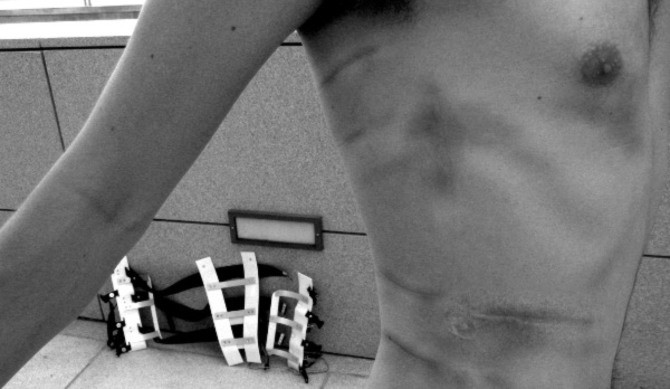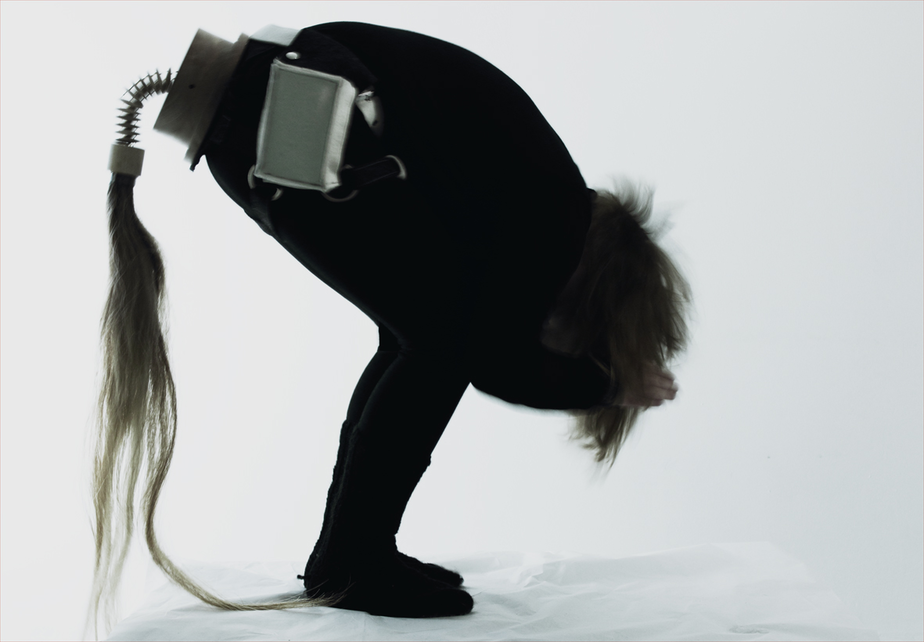Mia Hultgren - Sentimental Soft Robotics Skin (2016)
In Sentimental Soft Robotics Skin, Hultgren has placed transparent soft silicone robots with cast-in air pockets on human skin as a second skin layer. Hultgren describes how her practice is material-based, process-driven and experimental, and how she seeks an element of surprise in her designs by challenging the materials and techniques used in the processes (Hultgren n.d.). Although the work is not technically advanced in relation to soft robotics, it uses this technology in a more speculative manner to challenge how we perceive the human body. Sentimental Soft Robotics Skin explores the transition between synthetic and organic, and how the soft robot becomes a part of the wearer’s body. Hultgren introduces actuation and movement in textile design through air pockets whilst challenging which materials one might use for clothing, as an accessory or as an extension of the skin. The work was produced as part of a workshop facilitated by Caroline Yan Zheng, another pioneer in using soft robotics as a speculative design material with a focus on affective touch (see e.g. Zheng & Gross 2019)
Laura Beloff - Appendix (2011)
Laura Beloff’s Appendix is an example of a wearable technology art practice that relates to the concept of Umwelt. Beloff’s artistic practice and research investigates humans and technology in relation to localized environments as well as how wearable technologies alter our perception of the human body and relation to the surrounding world (Beloff 2014: 1). Appendix is a wearable tail that is designed to become a part of the wearer’s physiological body, but is controlled by external data connections (Beloff n.d.). The tail’s upward movements are controlled by real-time data of the wave height of the sea, while the tail’s side movements are controlled by real-time data of a public city transport system. Through these data connections, the wearable tail merges the wearer with the environment and explores how technology and wearables can be used to network humans to seemingly unrelated fields. Furthermore, Appendix comments on how humans are networked or connected to both human and non-human actors, and how these connections inherently impact our ways of understanding and acting in our surrounding environments. The primary aim with Appendix was to create an aesthetic experiment in which it is not known beforehand what kind of experience it will create, which rejects the rational approach to technology as a purposeful tool. Instead, Beloff speculates on how future humans will be networked to their environments through technology or "networked organs" to a degree that will enhance their abilities and reconfigure their senses and understanding of the world (Beloff 2014: 5). Hence, Beloff’s practice with Appendix investigates themes that are central to both the notion of the posthuman and the concept of Umwelt.
________________________________________________________________________________________________________________________________________________________________________________________
Francois Mangion and Becky Zhang - Furl (2014)
In Furl, Mangion and Zhang explore how soft robotics and kinetic design can be incorporated into architecture in a soft pneumatic pavilion consisting of inflatable soft silicone structures. The transparent soft silicone actuators all have simple designs with cast-in pneumatic networks (PneuNets) that allow the structures to curl when inflated. Furthermore, Furl introduces human brain-sensing (EEG-sensing) as the main controlling factor of the dynamic architectural pavilion. In that way, Mangion and Zhang’s project combines hard and soft architectural elements to investigate in which ways the users might interact with a setting and make it adapt to their particular needs. The division between hard and soft elements are also emphasized through the forms used. Straight lines and metallic materials are used for the hard parts, whilst curving triangles and soft silicone are used for the dynamic parts. This has the effect that the elements stand out in relation to each other. Furl challenges how architects can design for adaptive architecture and how mind and body can affect surrounding environments. Furthermore, the work suggests that soft robotics could become a key technology in architectural settings.
This page contains artworks that have served as inspirations throughout the research practice. The works have inspired the project in different ways - some are previous artworks and design projects that utilize soft robotics while others instead have a conceptual or aesthetic affinity with the project.
Gordan Savicic - Constraint City (2008, ongoing)
The ongoing project Constraint City - The Pain of Everyday Life is a performance in which Savicic walks through various cities wearing a chest strap with servo motors coupled to a WIFI-enabled Nintendo-console. Whenever Savicic approaches an encrypted wireless network along his way, the servo motors tighten the chest strap. The more powerful the wireless signal intercepted is, the tighter the corset becomes. Where technologies such as wireless networks are usually highly mediated through icons, visualisations and maps, Savicic reconfigures the technology through the wearable to offer a more embodied experience of his surroundings (Mackenzie 2010: 40). Thus, the wearable enables Savicic to physically sense signals that are otherwise absent from human sensory perception while it simultaneously imposes pain and bruises on his body.
Savicic (2008) explains how his work tries to address the way in which an invisible architecture is superimposed on our physical world and encapsulates as well as penetrates humans and buildings, within a resonant landscape built from electromagnetic waves. By using wearable technology beyond the scope of practical tasks, Savicic’s project allows him to see something familiar - the city - in a way that would not have been possible without extending his Merkorgans.
Jonathan Pêpe - Exo-biote (2015)
Exo-biote is a soft robotic installation produced by the artist in collaboration with researchers from Université de Lille. The work features an illuminated display case presenting multiple kinetic soft robotic sculptures. Exo-biote’s visual appearance is clean and simple with smooth and glossy surfaces and bright colors chosen for the soft silicone parts and the display case. The soft robots on display have visual aesthetics resembling unknown living organisms or limbs and yet appears to be sterile and mass-produced. Exo-biote roughly translates as ‘outside/external life’. The work has connotations of a shop display where customers are able to buy exo-organs and thereby customize or augment their bodies.
Exo-biote speculates on a future where the computer and the human body have entered an intimate relationship in which the closeness of the two leads to a structural modification of the technology (Pêpe n.d.). The installation explores how machines "become organic" through soft robot technology and questions whether seeing robots and electronics as something living and organic will become a common thought in a nearby future (Pêpe n.d.). By presenting the soft robots on display as forms of ready-to-use prostheses or surrogate organs, Pêpe’s work relates to discussions on how future generations will think about what constitutes living entities and to which degree they will accept do-it-yourself body modifications.
Maria Paneta and Ava Aghakouchak - Sarotis (2016)
Sarotis is an experimental study of different wearable soft robotic prostheses that integrate pneumatic inflation and liquid networks to inform the wearer about virtual and physical spaces. Paneta and Aghakouchak’s project investigates how technology can change the way we perceive and interact with our surrounding world. The designers conducted a study where they explored whether a human being’s awareness of space could be enhanced by using real-time 3D scanning coupled with their soft robotic wearable. Their findings suggest that the design could be used for people with visual impairments or as a tool to construct virtual spaces with a physical manifestation. Sarotis uses soft robotic technology to imitate the softness of the skin, and the technology is approached from an aesthetic angle through explorations of the color intensity, elasticity, and visual appearance of inflated pneumatic networks (Paneta 2016). Furthermore, the project seeks to question how future soft wearable technologies may blur the distinction between the organic human body and a synthesized soft entity to a degree where the latter becomes a natural extension of the body.
Recoil Performance Group - MASS -
Bloom Explorations (2018)
MASS is a part of Recoil’s Membrane Project that explores current perceptions of humanity and encounters between human and non-human bodies through choreography; in this instance, through a range of improvised live performances by Norwegian dance artist Hilde Ingeborg Sandvold. MASS revolves around a large plastic dome in which Sandvold performs in a basin containing around 200.000 mealworms eating foam plastic, Styrofoam. As the mealworms are able to eat human flesh, Sandvold is wearing a latex suit to prevent her from getting hurt. During her performance, Sandvold moves around slowly in the basin in a repetitive and almost animal way. Furthermore, the latex suit distorts her body’s visual aesthetic and make her appear like an unknown hybrid entity with traits similar to human beings but with a different material composition and other movement patterns. Meanwhile, a text written and read by Danish writer Ida Marie Hede is playing in the same room. Hede’s text is a future scenario explaining how the main character (played by Sandvold) lives in the plastic habitat and delves into her thoughts on the everyday life in a symbiotic system that embraces the worms, plastic and human entity. MASS as a whole becomes a speculative scenario that questions human extinction and survival strategies. The work explores consumer culture, the relation between the living and non-living and investigates our ties with other entities. Recoil’s work aims to present the installation’s visitors with an experience of how the main character tries to transform her body in an attempt to co-evolve with a species that has better prospects of survival than herself (Recoil Performance Group, n.d.). MASS questions whether humans can peacefully coexist with nature through the way we are currently consuming and living. Recoil’s work comments on how human exceptionalism and instrumentalism may need to be discarded for the survival of the human race.
Atsuku Tanaka - Electric Dress (1956)
An example of early wearable technology art is Japanese artist Atsuko Tanaka’s Electric Dress, where Tanaka recreates the traditional Japanese kimono purely with light bulbs to represent the modern world. Wearable works such as Electric Dress show a newfound interest in creating projects that move, change and interact with the environment (Kusahara 2016: 124).
Josh Kline - Creative Hands (2011) &
Tastemaker's Choice (2012)
Elements from the posthuman imaginary can be seen in American artist Josh Kline’s series Creative Hands and Tastemaker’s Choice. Creative Hands is a series of cast silicone objects that resemble different individual hands holding various consumer objects such as an iPhone, a computer mouse, a digital camera, and a bottled hand sanitizer. The hands and objects are cast as one and are colored in a warm beige. Similarly, Tastemaker’s Choice is a series of 3D printed objects that resemble hands holding an array of different drinking bottles. The objects are printed in a transparent plastic material and filled with various liquids, which merge the hand together with the drinking bottle. The objects of the two series are placed on backlit shelves similar to those found in shops, with connotations of a showcase of different commodities.
In both of Kline’s series, he explores the division between the organic and synthetic while simultaneously blurring the line between object and human, by making hybrid objects. The iPhone becomes skin-like in Creative Hands and the hand appears to be a plastic bottle in Tastemaker’s Choice. The hands are inseparably merged with the objects they are holding and even made in the same materials. This could be taken as an indication that consumer objects in the twenty first century, to some extent, have become a part of the human body and are viewed as something as natural as a functioning hand. The inseparability between hands and objects then invokes a literal as well as a metaphorical flow between humans and their surrounding environments and questions how these reciprocally influence each other (Doran & Homersham 2014). Kline’s works become physical manifestations of Verbeek’s (2008) and Pettman’s (2011) points, that humans are already posthuman and hybrid humanimals.
UBERMORGEN - Psych|OS -
Self Portrait (2002)
Swiss-Austrian-American artist duo UBERMORGEN mixes a range of artforms such as net art, installations, performances, and photography in their practice to comment on societal issues. In their series of works The Psych|OS Cycle (2001-2010) group member Hans Bernhard documents his life on drugs. Bernhard stayed at a psychiatric hospital in Vienna in the early 2000s due to having a mental breakdown. He filmed fragments of his stay with a video camera but allegedly forgot this due to his illness and the high doses of prescription drugs. The footage was found and exhibited as an installation by UBERMORGEN years later (Bernhard, n.d.). The work features a video showing various situations from Bernhard’s stay in which his general appearance is portrayed as being constantly manic and confused.
The name ‘Psych|OS’ is a reference to computer logic and operating systems. The comparison between computer operating systems and the human body as a system has been explored for more than half a century (see Bush 1945; Wiener 1948 and more recently Hayles 1999). In that way, the series’ title compares the human with a computer system and questions what happens if the human brain’s operating system crashes due to a virus malfunction or the brain’s ‘processors’ overheating. Psych|OS becomes an example of Pold’s (2011: 110) argument, that we begin to see and understand the world in a cybernetic interface-cultural loop as an effect of digitisation and through the continuing exposure to technology. This is also evinced in a statement from UBERMORGEN, where they argue that Bernhard is a ‘chemical cyborg’ who has been “(...) exposing, pushing, augmenting and enhancing his body with synthetic drugs for 25 years” (UBERMORGEN n.d.). The artists also state that “contemporary high-tech societies deal with hardcore brains using bio-chemical agents to enhance & control the internal information flow” which inherently makes us all chemical cyborgs (UBERMORGEN n.d.). When looking into Bernhard’s portrayal of chemically altering an individual's psyche, UBERMORGEN’s series of works could also question whether all technologically and chemically feasible solutions are ethically feasible.



































